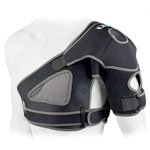Shoulder impingement syndrome occurs when the rotator cuff tendons in the shoulder are compressed or impinged. Here we explain some assessment tests that indicate impingement syndrome.
A professional therapist will perform a number of assessment tests to diagnose the cause of your shoulder pain.
60 degree arc test
A common sign with shoulder impingement is a pain in a 60-degree arc when lifting your arm out sideways and up above the shoulder.
Initially, you will feel little or no pain, then from about 70 degrees to 130 degrees pain is worse. If this is the case then the test is positive and shoulder impingement is indicated.
Neer’s sign
The therapist will position your arm with the thumb facing down and at a 45-degree angle to your body. They will then lift your arm up, above your head.
If you experience pain or discomfort, you may have an impingement of supraspinatus tendon.
Hawkins-Kennedy test
Your arm will be raised in front of you to 90° and the elbow bent. The therapist will then medially rotate (turn the wrist down and elbow up) the arm. If this causes pain you probably have an impingement of Supraspinatus.
Empty can test
You will be asked to put your arm out in front of you at a 45-degree angle to your body, with the thumb pointing to the floor (as if holding an empty can).
The therapist will ask you to raise your arm whilst they resist your movement. This tests the Supraspinatus tendon.
Imaging
An X-Ray or MRI may be used to identify what is causing the impingement.
More on Shoulder impingement









